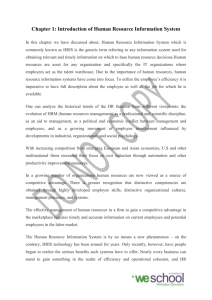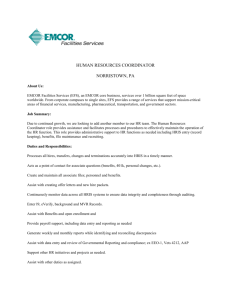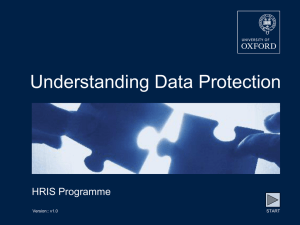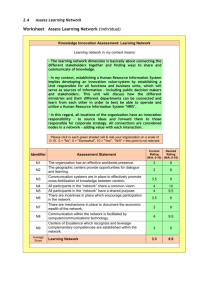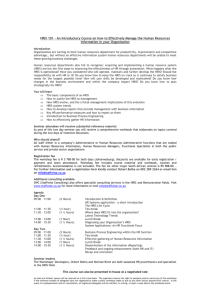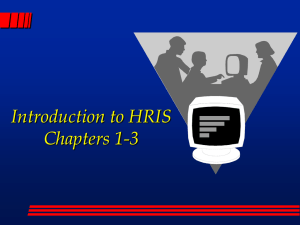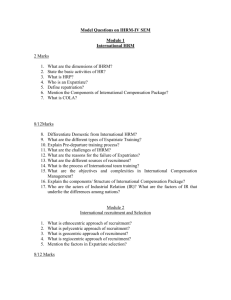The Impact of Human Resource Information Systems
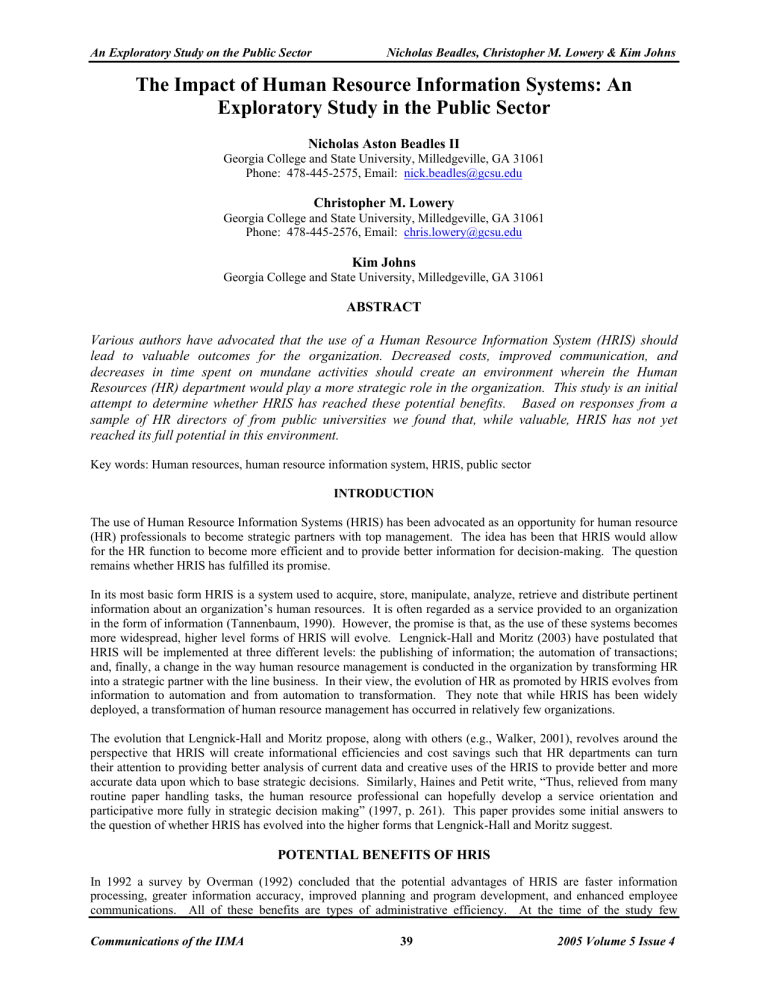
An Exploratory Study on the Public Sector Nicholas Beadles, Christopher M. Lowery & Kim Johns
The Impact of Human Resource Information Systems: An
Exploratory Study in the Public Sector
Nicholas Aston Beadles II
Georgia College and State University, Milledgeville, GA 31061
Phone: 478-445-2575, Email: nick.beadles@gcsu.edu
Christopher M. Lowery
Georgia College and State University, Milledgeville, GA 31061
Phone: 478-445-2576, Email: chris.lowery@gcsu.edu
Kim Johns
Georgia College and State University, Milledgeville, GA 31061
ABSTRACT
Various authors have advocated that the use of a Human Resource Information System (HRIS) should lead to valuable outcomes for the organization. Decreased costs, improved communication, and decreases in time spent on mundane activities should create an environment wherein the Human
Resources (HR) department would play a more strategic role in the organization. This study is an initial attempt to determine whether HRIS has reached these potential benefits. Based on responses from a sample of HR directors of from public universities we found that, while valuable, HRIS has not yet reached its full potential in this environment.
Key words: Human resources, human resource information system, HRIS, public sector
INTRODUCTION
The use of Human Resource Information Systems (HRIS) has been advocated as an opportunity for human resource
(HR) professionals to become strategic partners with top management. The idea has been that HRIS would allow for the HR function to become more efficient and to provide better information for decision-making. The question remains whether HRIS has fulfilled its promise.
In its most basic form HRIS is a system used to acquire, store, manipulate, analyze, retrieve and distribute pertinent information about an organization’s human resources. It is often regarded as a service provided to an organization in the form of information (Tannenbaum, 1990). However, the promise is that, as the use of these systems becomes more widespread, higher level forms of HRIS will evolve. Lengnick-Hall and Moritz (2003) have postulated that
HRIS will be implemented at three different levels: the publishing of information; the automation of transactions; and, finally, a change in the way human resource management is conducted in the organization by transforming HR into a strategic partner with the line business. In their view, the evolution of HR as promoted by HRIS evolves from information to automation and from automation to transformation. They note that while HRIS has been widely deployed, a transformation of human resource management has occurred in relatively few organizations.
The evolution that Lengnick-Hall and Moritz propose, along with others (e.g., Walker, 2001), revolves around the perspective that HRIS will create informational efficiencies and cost savings such that HR departments can turn their attention to providing better analysis of current data and creative uses of the HRIS to provide better and more accurate data upon which to base strategic decisions. Similarly, Haines and Petit write, “Thus, relieved from many routine paper handling tasks, the human resource professional can hopefully develop a service orientation and participative more fully in strategic decision making” (1997, p. 261). This paper provides some initial answers to the question of whether HRIS has evolved into the higher forms that Lengnick-Hall and Moritz suggest.
POTENTIAL BENEFITS OF HRIS
In 1992 a survey by Overman (1992) concluded that the potential advantages of HRIS are faster information processing, greater information accuracy, improved planning and program development, and enhanced employee communications. All of these benefits are types of administrative efficiency. At the time of the study few
Communications of the IIMA 39 2005 Volume 5 Issue 4
An Exploratory Study on the Public Sector Nicholas Beadles, Christopher M. Lowery & Kim Johns researchers thought to explore possible strategic advantages and even today while there are various studies which recognize that strategic benefits may exist, they fail to explain how those benefits are realized within an organization and they fail in attempting to measure whether those benefits have occurred.
Some authors have proposed that the use of a HRIS would reduce HR costs by automating information and reducing the need for large numbers of HR employees; by helping employees to control their own personal information; and by allowing managers to access relevant information and data, conduct analysis, make decisions, and communicate with others without consulting an HR professional (Awazu & Desouza, 2003; Ball, 2001). Ideally, with an appropriate use of HRIS, less people should be needed to perform administrative tasks such as record keeping and more time would be made available for HR managers to assist by providing data on a strategic level. Many of these authors believe the future to be bright for HRIS as it creates new paths for human resources and for the organizations that effectively use HRIS. One study even goes as far as to suggest that there is evidence that HRIS can improve shareholder value (Brown, 2002).
A significant problem with deciding whether HRIS benefits the organization is that of measuring the effect of HR and more particularly HRIS on the bottom line. There are few clear cut ways to measure the value of HRIS. While there are measurements for administrative HRIS such as cost reductions in HR departments, it is difficult to measure precisely the return on investment and specific improvements in productivity within the HR departments (Mayfield,
Mayfield, and Lunce, 2003). Indeed, while the ideal assessment of HRIS success might include hard measures such as ROI, the control of extraneous variables makes this type of measurement of success difficult if not impossible.
This is why user satisfaction and perception of the system has often be used as a proxy measure for the effectiveness of the system (Haines and Petit, 1997)
ADMINISTRATIVE AND STRATEGIC IMPLEMENTATIONS OF HRIS
In examining the benefits of HRIS there are two extremes, the pure administrative use of HRIS and its strategic use.
Ultimately the goal of both is to increase organizational value. HRIS efficiency and administrative effectiveness can be described by studies of administrative HRIS, but the overall efficiency and effectiveness of an organization can only be reached through strategic deployment of the information provided by an HRIS.
Administrative HRIS is used in day-to-day operations and it is usually in the form of records that hold employee information. Administrative HR is much more efficient when it is used with IT because HR professionals are better able to handle large amounts of information efficiently. For instance, Watson Wyatt’s survey report (2002) concluded that it does not take a high progression of e-HR to reach high HRIS performance on the administrative side. The results showed that a properly integrated e-HR system is the key to the evolution of the system. The survey covered all organization sizes, and the measures used included productivity improvements within the HR organization, cost reductions, return on investment, and enhanced employee communications. They concluded that by properly implementing an e-HR system an organization should be able to reduce the amount of work for which the HR department is responsible which would then leave HR professionals free to concentrate on performing more strategic roles for the organization.
In contrast to administrative HRIS, strategic HRIS is much more difficult to explain and measure because there is no way to be sure that the benefits are a direct result of strategic deployment of an HRIS system. Strategic HRIS consists of tools that assist in decision making. For example strategic decisions may include those associated with recruitment and retaining employees. Much, if not all, of the administrative information held by HRIS can be used to analyze an organization and formulate strategies to increase the value of an HRIS. Some experts also believe that easy access to vital information will become an integrated part of many strategic decision-making process (Kovach,
Hughes, Fagan, Maggitti, 2002). But, the possibilities of strategic deployment still remain useless without a way of getting there.
EXPLORATORY QUESTIONS for the PRESENT STUDY
The purpose of our study is to gather information regarding the implementation of an HRIS, the perceived benefits of the HRIS, satisfaction with that system, and, lastly, its strategic impact. Human resource information systems play a vital role in many businesses today, yet few studies have been conducted on HRIS in relation to other aspects of the HR function. Even fewer reports show the strategic/analytical parts of HRIS; however, they do discuss the administrative segment. The most important section, although neglected completely, is on how to improve a firm’s decision making through analysis of the information provided by HRIS. Much of the literature provides information
Communications of the IIMA 40 2005 Volume 5 Issue 4
An Exploratory Study on the Public Sector Nicholas Beadles, Christopher M. Lowery & Kim Johns discussing possible strategic roles of HRIS, but none have explored a way to realize these roles and deploy them in an efficient way.
So far, the literature has been focused primarily on profit-based organizations in the private sector of the market.
How do public sector organizations use HRIS? Do they deploy HRIS for administrative purposes alone? Do public organizations realize that strategic benefits exist?
The surveys conducted thus far have concentrated mostly on the private sector and the topical, more administrative, deployment of HRIS. This study focused on the public sector implementation of HRIS, specifically the implementation of HRIS within public universities. The main questions we sought to address were: have human resource information systems reached the administrative potential of HRIS in HR departments at universities, and have they reached the strategic goals? We also attempted to assess satisfaction with the system.
METHOD
A survey was developed and sent to the Human Resource Directors of public universities in a state university system in the Southeastern United States. We wished to asses the strategic impact of HRIS, so the surveys were targeted at
HR directors rather than lower level users of the system. All of the institutions in the university system employed the same software package for their HRIS, which removed the potential of variation in responses due to different software vendors. The targeting of higher level personnel and the standardization of the software reduced the potential population for our sample. Approximately 30 surveys were sent and eleven usable surveys were returned.
Likert-type items on a five point scale and open-ended questions were employed on the survey to measure the perceptions of the HR directors in regard to the impact of the HRIS on HR processes, the time spent on various HR activities, the expense of HR activities, levels and use of information within the organization, the role of the HR department, and strategic decision making. Little empirical investigation has been conducted on these topics. While previous research has assessed satisfaction with and the amount of usage of HRIS systems (Haines and Petit, 1997) and the types of applications for which HRIS is used (Elliott and Tevavichulada, 1999; Ball, 2001), few if any empirical studies have addressed the issues of concern in the current study. The items on the survey were generated based upon suggestions developed from review of the previous literature in general, and Watson Wyatt (2002) and
Feigenbaum (1983) in particular in regard to costs.
RESULTS
This research was exploratory and primarily descriptive in nature; we were interested in determining whether HR directors perceived that human resource information systems were fulfilling their promise in regard to their potential strategic impact in organizations. We also had a relatively small sample size, as mentioned above. Therefore, we used frequency tables to measure the percentage of favorable responses to a series of questions assessing HR directors’ perceptions of HRIS. The survey items are contained in Figure 1. The results of the survey are contained in Tables 1 through 7. The percentages expressed are the percentage of respondents for each item who either agreed or strongly agreed with the statement. The items are divided into categories concerning satisfaction with the
HRIS (Table 1); the impact of the HRIS on HR processes (Table 2); time savings due to the HRIS (Table 3); the effect of the HRIS on expenses (Table 4), information (Table 5), and decision-making (Table 6); and the strategic impact of the HRIS and the impact of the HRIS on the role of the HR function in the organization (Table 7).
As can be seen in Table 1, the HR directors seemed to be, in general, overwhelmingly pleased with the HRIS, as
90% were satisfied with the system, and 80% believed that their HR employees were satisfied also. An often overlooked implementational issue is getting staff to accept a new system (Kovach, Hughes, Fagan, and Maggitti,
2002), so this obstacle appears to have been overcome in this instance. However, while they and their employees were satisfied with the system, the majority (70%) of the directors believed that it could be better utilized and only
60% responded that it had met their expectations.
Item % Agree
Overall I am satisfied with our HRIS. 90
The employees of the Human Resources (HR) department appear to be satisfied with our HRIS. 90
Our HRIS has met our expectations.
Our HRIS could be better utilized.
60
70
Table1: Satisfaction with the HRIS.
Communications of the IIMA 41 2005 Volume 5 Issue 4
An Exploratory Study on the Public Sector Nicholas Beadles, Christopher M. Lowery & Kim Johns
Targowski and Deshpande (2001) and others have suggested that part of the utility of an HRIS is its positive impact on traditional HR processes such as recruitment , selection and training and development. However, Table 2 indicates that, even though the HR directors were mostly satisfied with the system, they did not perceive that it had much impact on recruitment, training, or forecasting of staffing needs, with only a few respondents indicating a positive effect in these areas. There was, however, a somewhat more positive view of the effect on data input and data maintenance, with 50% and 60% of respondents, respectively, agreeing that these processes had seen improvement due to the HRIS.
Item % Agree
Our HRIS has improved the recruitment process.
Our HRIS has improved the training process.
11
10
Our HRIS has improved the data input process. 50
Our HRIS has improved the data maintenance process. 60
Our HRIS has helped with forecasting staffing needs. 10
Our HRIS has decreased paperwork. 30
Table 2: HR Processes.
One of the general purported benefits of HRIS applications is to reduce time spent on administrative processes
(Kovach and Cathcart, 1999; Targowski and Deshpande, 2001) and yet the results show that the effects of the HRIS on time savings are mixed, at best (see Table 3). Again, the traditional HR tasks of recruiting, training, and staffing were not positively effected, as there was little or no perceived decrease in the amount of time spent on these activities or on the time spent communicating information within the institution. At least half of the respondents, however, believed that their institution had realized some savings in the time spent on processing paperwork and on correcting errors, and as might be surmised from the results in Table 2, on time spent inputting data.
Item
Our HRIS has decreased the time spent on recruiting.
Our HRIS has decreased the time spent on training.
Our HRIS has decreased the time spent on making staff decisions.
Our HRIS has decreased the time spent on inputting data.
%Agree
0
0
0
50
Our HRIS has decreased the time spent on communicating information within our institution. 20
Our HRIS has decreased the time spent on processing paperwork. 50
Our HRIS has decreased the time spent on correcting errors. 60
Table 3: Time Savings.
One of the proposed advantages of human resource information systems is that processing costs should be reduced
(Kovach and Cathcart, 1999). Legnick-Hall and Moritz reported first year costs savings for Dell Computer’s new e-
HR system of $2.5 million. Regarding cost reductions for public universities, as can be seen in Table 4, the perceived effects of the HRIS were negligible. Few, if any, of the HR directors perceived any decreases in training, recruiting, data input or hiring expenses or in the amount spent on HR salaries.
Item
Our HRIS has decreased cost per hire.
Our HRIS has decreased training expenses.
% Agree
20
0
Our HRIS has decreased recruiting expenses.
Our HRIS has decreased data input expense.
0
40
Our HRIS has decreased the overall HR staff’s salary expense. 10
Table 4: Cost Savings.
One area in which the HRIS apparently has had strong positive effects involves information. Kovach, Hughes,
Fagan, and Maggitti (2002) suggest that the HRIS will become the mechanism for sharing information across the functional area of an organization. As Table 5 reveals, 80% of the HR directors believe that the HRIS has improved their ability to disseminate information and has also increased the amount of useful information, while 70% share
Communications of the IIMA 42 2005 Volume 5 Issue 4
An Exploratory Study on the Public Sector Nicholas Beadles, Christopher M. Lowery & Kim Johns information generated by the HRIS with high level university administrators. However, 80% also believe that the information generated by the HRIS in not fully utilized by the top administrators and only 40% think that the HRIS has enhanced coordination between the HR department and the administrators. Finally, 90% believe that the information generated by the HRIS results in value added to the organization.
Item
Our HRIS has improved our ability to disseminate information.
Our HRIS has provided increased levels of useful information.
The information generated from our HRIS is shared with top administrators.
The information generated from our HRIS is underutilized by top administrators.
The information generated from our HRIS has increased coordination between HR department and top administrators.
The information generated from our HRIS has added value to the institution.
Table 5: Information Effects.
% Agree
80
80
70
80
40
90
The functions provided by HRIS that allow for the type and amount of the information provided to top management and the effectiveness of the HR department to make better decisions are important in research of the system
(Lengnick-Hall and Moritz, 2003). A general purpose of an HRIS is to provide decision support applications that help HR and non-HR managers, as well as employees, make better decisions, and the key is to make better decisions rather than simply produce data faster (Kovach and Cathcart, 1999). Based on the results contained in Table 6, however, the HRIS appears to have little effect on decision making. Fewer that half of the HR directors perceived that HR decision making had become more effective, and the results were similarly negative pertaining to the impact of HRIS on decisions concerning promotion and especially those decisions related selection and the timing of training and of hiring. One area where respondents believed that the system did aid in making decisions concerns promotions, with 60% responding that it provides useful information.
Item
Our HRIS has made our HR decision-making more effective.
% Agree
40
The information generated from our HRIS helps our institution decide on employee raises.
The information generated from our HRIS helps our institution to make more effective promotion decisions.
The information generated from our HRIS helps our institution decide when to hire.
The information generated from our HRIS helps our institution make better decisions in choosing
60
40
10
10 better people.
The information generated from our HRIS helps our institution decide when training and skill development are necessary.
Table 6: Decision Making.
10
HRIS has been envisioned as having a substantial impact on the importance of human resource departments, leading to a more strategic/managerial role and contributing to the organization’s competitiveness, as well as creating new paths for HR to add value to the organization (Lengnick-Hall and Moritz, 2003). However, HR directors did not perceive that the HRIS had a positive impact on the role of the human resources department in the organization, with only 30% and 40%, respectively, agreeing that the HR department had become more important and had become more of a strategic partner in the institution. As early as the mid 1990’s the focus of HRIS had begun to shift because of its usefulness in strategic decision making (Kovach, Hughes, Fagan, and Maggitti, 2002). Regarding the strategic impact, only 50% of the directors responded that the administrators thought the HRIS helped them to meet strategic goals, and just 40% believed that it had improved the strategic decision making of top administrators.
Finally, only 20% felt that it had aided in the promotion of the institution’s competitive advantage.
Item
Our HRIS has made the HR department more important to the institution.
Overall our administration thinks that HRIS is effective in meeting strategic goals.
The information generated from our HRIS has improved the strategic decision making of top administrators.
The information generated from our HRIS has made HR a more strategic partner in the institution.
Our HRIS has promoted our institution’s competitive advantage.
% Agree
30
50
40
40
20
Table 7: Strategic Impact and HR’s Role
Communications of the IIMA 43 2005 Volume 5 Issue 4
An Exploratory Study on the Public Sector Nicholas Beadles, Christopher M. Lowery & Kim Johns
CONCLUSION
Based on a sample of HR directors, the results concerning the impact of HRIS in a public sector setting are encouraging, but mixed. The directors overall are satisfied with the system, but don’t yet see many benefits from its usage outside of its effect on information and information sharing. Part of the problem may stem from the type of organizations that were sampled. Recruiting, hiring, and training probably are handled somewhat differently for public sector employees as compared to employees of private sector organizations, so HRIS in its current form may not yet have had much positive impact in these areas. Yet, it appears that there is potential for these benefits, as a large majority of the directors believed that the HRIS was not being fully utilized.
An indication of another potential problem was revealed in the answers to open-ended questions on the survey seeking additional feedback. Frequently mentioned by the respondents was the need for more training on the system. They believed that additional and better training would lead to better results. Several of the responses also reinforced the notion that the system was being underutilized and that they were not taking full advantage of the capabilities. They believed that other applications were needed and that the system could be more effectively utilized with the addition of some other features that were not currently part of the system. So, the potential contributions of HRIS are recognized, but further advances are need before the potential can be realized.
APPENDIX
Response Key:
1 strongly disagree
2 disagree
3
4
5 neutral agree strongly agree
1.
I am actively involved with the Human Resource Information System (HRIS).
2.
Overall I am satisfied with our HRIS.
(Items used in the survey)
1
SD
2
D
3
N
4
A
5
SA
3.
The employees of the Human Resources (HR) department appear to be satisfied with our HRIS.
4.
Overall we are satisfied with the modules we have installed and are available for use.
5.
Our HRIS has met our expectations.
6.
Our HRIS could be better utilized.
7.
Our HR employees understand how to use the Human Resource Information System.
8.
Our HRIS has made our HR decision-making more effective.
9.
Our HRIS has made the HR department more important to the institution.
10.
We are satisfied with the deployment of our HRIS.
11.
We are satisfied with the support we have received from our information technology
(IT) department.
12.
We are satisfied with the support we have received from the software vendor.
13.
We are satisfied with the flexibility of the system.
14.
Our HRIS has decreased the time spent on recruiting.
15.
Our HRIS has decreased the time
16.
Our HRIS has decreased the time spent on
17.
Our HRIS has decreased the time spent on inputting data.
18.
Our HRIS has decreased the time spent on communicating information within our institution.
19.
Our HRIS has decreased the time spent on processing paperwork.
20.
Our HRIS has decreased the time spent
21.
Our HRIS has decreased cost per hire.
22.
Our HRIS has decreased training expenses.
23.
Our HRIS has decreased recruiting expenses.
24.
Our HRIS has decreased data input expense.
25.
Our HRIS has decreased the overall HR staff’s expense.
Communications of the IIMA 44 2005 Volume 5 Issue 4
An Exploratory Study on the Public Sector Nicholas Beadles, Christopher M. Lowery & Kim Johns
26.
Our HRIS has improved our ability to disseminate information.
27.
Our HRIS has provided increased levels of useful information.
28.
Our HRIS has improved the recruitment
29.
Our HRIS has improved the training process.
30.
Our HRIS has improved the data input process.
31.
Our HRIS has improved the data maintenance process.
32.
Our HRIS has helped with forecasting needs.
33.
Our HRIS has decreased paperwork.
34.
Our HRIS has increased security
35.
The information generated from our HRIS is shared with top administrators.
36.
The information generated from our HRIS is underutilized by top administrators.
37.
The information generated from our HRIS has increased coordination between HR department and top administrators.
38.
The information generated from our HRIS has added value to the institution.
39.
The information generated from our HRIS helps our institution decide on employee raises.
40.
The information generated from our HRIS helps our institution to make more effective promotion decisions.
41.
The information generated from our HRIS helps our institution decide when to hire.
42.
The information generated from our HRIS helps our institution make better decisions in choosing better people.
43.
The information generated from our HRIS helps our institution decide when training and skill development are necessary.
44.
Overall our administration thinks that HRIS is effective in meeting strategic goals.
45.
The information generated from our HRIS has improved the strategic decision making of top administrators.
46.
The information generated from our HRIS has made HR a more strategic partner in the institution.
47.
Our HRIS has promoted our institution’s competitive advantage.
48. We are satisfied with the way in which system upgrades have been installed.
1 strongly disagree ___
2 disagree ___
5 strongly agree
6 not applicable
___
___
49. System upgrades have improved the HRIS system.
1 strongly disagree ___
2 disagree ___
5 strongly agree
6 not applicable
___
___
Demographic Information
How long has the HRIS system been in place?What is the size of your institution (approximately what # of full-time students)?
_____ Less than 2001
_____2001 to 5000
_____5001 to 10,000
_____10,001 to 15,000
_____15,001 to 20,000
_____Greater than 20,000
What is your position in the institution?
What HRIS system do you currently employ?
Communications of the IIMA 45 2005 Volume 5 Issue 4
An Exploratory Study on the Public Sector Nicholas Beadles, Christopher M. Lowery & Kim Johns
Please provide any additional information that you think would be helpful in my analysis?
Would you like to receive the results of this survey (if so please provide a means of contact).
REFERENCES
Awazu, Yukika & Desouza, Kevin C. (2003). Knowledge Management. HRMagazine. 48(11), 107.
Ball, Kirstie S. 2001. The Use of Human Resource Information Systems: a Survey. Personnel Review. 30(6) , 667-
693.
Brown, David. (2002). eHR – Victim of Unrealistic Expectations. Canadian HR Reporter. 15(16), 1, 6.
Elliott, Dr., Robert H. & Tevavichulada. (1999). Computer Literacy and Human Resource Management: A
Public/Private Sector Comparison. Public Personnel Management. 28( 1), 259-274.
Feigenbaum, A. V. (1983). Total Quality Control: Engineering and Management . 3rd ed. New York: McGraw Hill.
Haines, Victor Y., Petit, Andre. (1997). Conditions for Successful Human Resource Information Systems. Human
Resource Management. 36( 2) , 261-275.
Kovach, Kenneth A. & Cathcart, Jr., Charles E. (1999). Human Resource Information Systems (HRIS): Providing
Business with Rapid Data Access, Information Exchange and Strategic Advantage. Public Personnel
Management. 28( 2), 275-282.
Kovach, Kenneth A, Hughes, Allen A. , Fagan, Paul, & Maggitti, Patick . (2002). Administrative and Strategic
Advantages of HRIS. Employment Relations Today. 29( 2) 43-48.
Lengnick-Hall, Mark L. & Moritz, Steve. (2003). The Impact of e-HR on the Human Resource Management
Function. Journal of Labor Research. 24( 3), 365-379.
Mayfield, J., Mayfield, M., & Lunce, S. (2003). Human Resource Information Systems: A Review and Model
Development. Advances in Competitiveness Research. 11( 1), 139-151.
Overman, S. (1992). Reaching for the 21 st
Century. HR Magazine, 37, 61-63 .
Tannenbaum, S.I. (1990). Human ResourceIinformation Systems: User Group Implications . Journal of Systems
Management. 41(1), 27-32.
Targowski, Andrew S & Deshpanade, Satish P. (2001). The Utility and Selection of an HRIS. Advances in
Competitive Research. 9 (1) 42-56 .
Walker, Alfred J. (2001). How the Web and Other Trends are Changing Human Resources. In Alfred J. Walker, ed.,
Web-Based Human Resources.
New York: McGraw-Hill, 2001.
Watson Wyatt. (2002). e-HR: Getting Results Along the Journey – 2002 Survey Report . Watson Wyatt Worldwide.
Communications of the IIMA 46 2005 Volume 5 Issue 4
